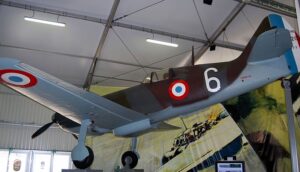Time Period: World War II
Country of Origin: United States
Type: Fighter Aircraft, Reconnaissance and Surveillance, Bomber Aircraft
Manufacturer: Lockheed Corporation
Lockheed P-38 Lightning Aircraft Overview
The Lockheed P-38 Lightning was a twin-engine fighter aircraft used by the United States during World War II. It was designed and built by the Lockheed Corporation and was first flown in 1939.
The P-38 was unique in that it featured a twin-boom design with the engines mounted on the wings, rather than in the fuselage. This gave it a distinctive appearance and improved its stability and maneuverability. The P-38 was also one of the fastest aircraft of its time, with a top speed of around 400 mph.
The P-38 was armed with a variety of weapons, including machine guns and cannons. It was used in a variety of roles during the war, including as a fighter, fighter-bomber, and reconnaissance aircraft. The P-38 also played a significant role in the Pacific Theater, where it was used to intercept Japanese aircraft and escort bombers.
One of the most famous P-38 pilots was Richard Bong, who became America’s highest-scoring ace during World War II, with 40 confirmed kills. Other notable P-38 pilots included Thomas McGuire, who was the second-highest-scoring American ace, and Charles Lindbergh, who flew P-38s on reconnaissance missions in the Pacific.
A total of 10,037 P-38s were built, and the aircraft continued to serve with some air forces even after the war ended. Today, several P-38s survive and are flown in air shows and museum exhibitions around the world.
Lockheed P-38 Lightning (P-38L) Specifications
- Crew: 1
- Length: 37 ft 10 in (11.53 m)
- Wingspan: 52 ft 0 in (15.85 m)
- Height: 12 ft 10 in (3.91 m)
- Wing area: 327.5 sq ft (30.43 m2)
- Aspect ratio: 8.26
- Airfoil: root: NACA 23016; tip: NACA 4412
- Empty weight: 12,800 lb (5,806 kg)
- Gross weight: 17,500 lb (7,938 kg)
- Max takeoff weight: 21,600 lb (9,798 kg)
- Powerplant: 2 × Allison V-1710 (-111 left hand rotation and -113 right hand rotation) V-12 liquid-cooled turbo-supercharged piston engine, 1,600 hp (1,200 kW) each WEP at 60 inHg (2.032 bar) and 3,000 rpm
- Propellers: 3-bladed Curtiss electric constant-speed propellers (LH and RH rotation)
Lockheed P-38 Lightning (P-38L) Performance
- Maximum speed: 414 mph (666 km/h, 360 kn) on Military Power: 1,425 hp (1,063 kW) at 54 inHg (1.829 bar), 3,000 rpm and 25,000 ft (7,620 m)
- Cruise speed: 275 mph (443 km/h, 239 kn)
- Stall speed: 105 mph (169 km/h, 91 kn)
- Combat range: 1,300 mi (2,100 km, 1,100 nmi)
- Ferry range: 3,300 mi (5,300 km, 2,900 nmi)
- Service ceiling: 44,000 ft (13,000 m)
- Rate of climb: 4,750 ft/min (24.1 m/s)
- Lift-to-drag: 13.5
- Wing loading: 53.4 lb/sq ft (261 kg/m2)
- Power/mass: 0.16 hp/lb (0.26 kW/kg)
- Drag area: 8.78 sq ft (0.82 m2)
- Zero-lift drag coefficient: 0.0268
Lockheed P-38 Lightning (P-38L) Armament
- Guns:
- 1× Hispano M2(C) 20 mm cannon with 150 rounds
- 4× M2 Browning machine gun 0.50 in (12.7 mm) machine guns with 500 rpg.
- Rockets: 4× M10 three-tube 4.5 in (112 mm) M8 rocket launchers; or:
- Bombs:
- Inner hardpoints:
- 2× 2,000 lb (907 kg) bombs or drop tanks; or
- 2× 1,000 lb (454 kg) bombs or drop tanks, plus either
- 4× 500 lb (227 kg) bombs or
- 4× 250 lb (113 kg) bombs; or
- 6× 500 lb (227 kg) bombs; or
- 6× 250 lb (113 kg) bombs
- Outer hardpoints:
- 10× 5 in (127 mm) HVARs (High Velocity Aircraft Rockets); or
- 2× 500 lb (227 kg) bombs; or
- 2× 250 lb (113 kg) bombs
- Inner hardpoints:
Lockheed P-38 Lightning Image Gallery
More Lockheed Aircraft

Lockheed P-3 Orion
The Lockheed P-3 Orion is an American four-engined, turboprop anti-submarine and maritime surveillance aircraft.

Lockheed Martin X-35
The Lockheed Martin X-35 is a concept demonstrator aircraft developed by Lockheed Martin for the Joint Strike Fighter program.

Lockheed Martin F-22 Raptor
The Lockheed Martin F-22 Raptor is an American twin-engine, single-seat, all-weather stealth tactical fighter aircraft developed for the USAF.

Lockheed F-117 Nighthawk
The Lockheed F-117 Nighthawk is a retired American single-seat, twin-engine stealth attack aircraft developed by Lockheed Skunk Works.

Lockheed U-2
The Lockheed U-2 or “Dragon Lady” is an American single-engine, high-altitude reconnaissance aircraft first introduced in 1956.










